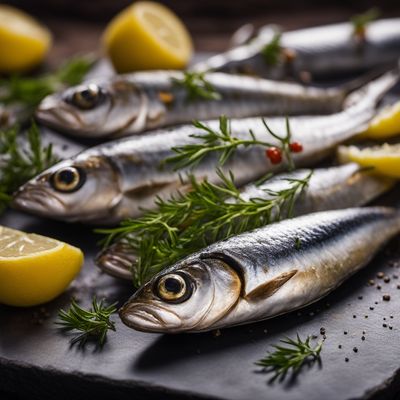
Ingredient
European sardine
The Versatile Delicacy: European Sardine
European sardines are small, oily fish with a firm texture and a rich, savory flavor. They have a silvery-blue skin and are characterized by their elongated shape and sharp, pointed fins. These nutrient-dense fish are commonly used in Mediterranean cuisine and can be grilled, fried, or canned for extended shelf life.
Origins and history
European sardines have been a staple in Mediterranean diets for centuries, with evidence of their consumption dating back to ancient times. They were highly valued by ancient civilizations, such as the Greeks and Romans, for their abundance and nutritional benefits. European sardines have also played a significant role in the fishing industry and coastal communities throughout history.
Nutritional information
European sardines are an excellent source of omega-3 fatty acids, which promote heart health and reduce inflammation. They are also a good source of protein, vitamins B12 and D, and minerals like calcium and selenium. With approximately 200 calories per 100 grams, they provide a satisfying and nutritious addition to meals.
Allergens
May contain fish allergens.
How to select
When selecting European sardines, look for fish that have bright, clear eyes, shiny skin, and a fresh, oceanic smell. The flesh should be firm and resilient to the touch. If purchasing canned sardines, check the expiration date and ensure that the cans are not dented or damaged.
Storage recommendations
Fresh European sardines should be consumed within a day or two of purchase. If storing for a longer period, they can be frozen in airtight containers or wrapped tightly in plastic wrap. Canned sardines can be stored in a cool, dry place for an extended period. Once opened, refrigerate any leftovers and consume within a few days.
How to produce
European sardines can be commercially fished or caught recreationally using nets or fishing lines. They are abundant in the Mediterranean Sea and are also found in the Atlantic Ocean. For home cultivation, it is not feasible to produce European sardines as they require large bodies of water to thrive.
Preparation tips
European sardines can be enjoyed in various ways, such as grilling, frying, or baking. They can be marinated in olive oil, lemon juice, and herbs before cooking to enhance their flavor. Sardines are often served whole, either as a main course or as a topping for salads, pizzas, or bruschetta. They can also be mashed and used in spreads, pâtés, or as a filling for sandwiches.
Substitutions
Anchovies, mackerel, or herring can be used as substitutes for European sardines due to their similar flavor and texture.
Culinary uses
European sardines are commonly used in Mediterranean cuisine, including dishes like pasta with sardines, sardine escabeche, and sardine-stuffed peppers. They are also a popular ingredient in canned fish products, such as sardine pâté or sardine sandwiches. Additionally, sardines can be used to add depth of flavor to sauces, stews, and soups.
Availability
Mediterranean countries, including Spain, Portugal, Italy, and Greece
More ingredients from this category
Recipes using European sardine

Sfogi in Saor
Venetian Delight: Sfogi in Saor

Portuguese Cebolada with Grilled Sardines
Sizzling Sardines in Portuguese Onion Sauce

Sicilian-style Baked Sardines with Oregano and Bread Crumbs
Mediterranean Delight: Crispy Baked Sardines with Fragrant Oregano and Crunchy Bread Crumbs

Libyan Spiced Sardines
Harissa-infused Sardines: A Taste of Libya
